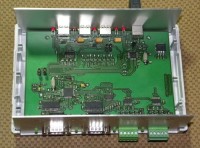4-Channel USB-to-Serial Converter + 3-Port USB Hub [140033]

Cool project. Offers a serial to USB bridge featuring two full 9-pin RS-232 ports plus two RS-422 ports (full-duplex). In addition to this the device also integrates a USB hub, giving three supplemental USB ports. Jumpers allow bypassing of the USB hub, making it easy to test the serial bridge all by itself.
Cool project. Offers a serial to USB bridge featuring two full 9-pin RS-232 ports plus two RS-422 ports (full-duplex). In addition to this the device also integrates a USB hub, giving three supplemental USB ports. Jumpers allow bypassing of the USB hub, making it easy to test the serial bridge all by itself.
The circuit was designed by Sébastien Guerreiro de Brito who proposed it to us.
We at Elektor.Labs have cleaned up the PCB, fixed some BOM issues and added a few extras:
- Shield connections to ground plane through optional R/C filter networks for the USB, RS-232 and RS-422 ports.
- Since the datasheet of the FT4232 shows multiple reset circuits, we have added them all.
- Connector for external power.
- Jumper for selection of USB per-port power or ganged.
- Jumper for selection of self-powered or bus-powered operation of the USB hub.
LEDs show port activity.
The jumpers on the board do this:
- JP1 & JP2: terminate the RS-422 ports with 120 ohms resistors
- JP3 & JP4: 1-2 serial bridge only, 2-3 serial bridge plus USB hub
- JP5 & JP6: remove for serial bridge only
- JP7: 1-2 USB downstream port ganged power, 2-3 per-port power
- JP8: 1-2 bus powered, 2-3 self powered
The FTDI tool FT_Prog (http://www.ftdichip.com/Support/Utilities/FT_Prog_v2.8.2.0.zip) is needed to activate the RS-422 options of the serial bridge. An on-board EEPROM is available for storing the chip's configuration.
The design fits nicely in a standard Vero enclosure.
No firmware needed, all you may need are FTDI USB drivers. The USB hub should not need a driver (except maybe on very old systems).
Update 21/8/2014
We had some problems to get our prototypes working. One worked fine, two others didn't. Only the hub-part worked on all boards, but not the FT24232H. After som investigations we discovered that the culprit was the EMC filtering on the USB data lines. The FTDI chip FT24232H is a Hi-speed USB device which is not compatible with the typical RC networks you often see on the datalines in Full-speed USB designs. Removing the capacitors from the datalines did the trick.
Also note that the USB protection chip SN75240 is not suitable for Hi-speed USB.
The schematic and PCB have been updated to reflect the changes.
Our new prototypes based on these files worked first time, which is great. Drivers install fine and we can now start testing the serial ports.
Update 24/11/2014
Added mechanical drawings (FPD files) to download.



Discussion (5 comments)